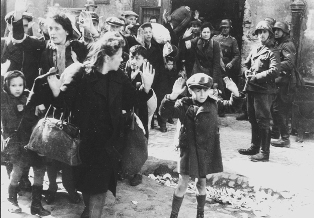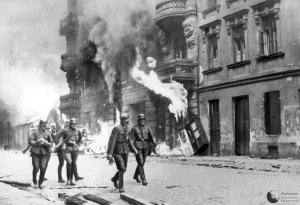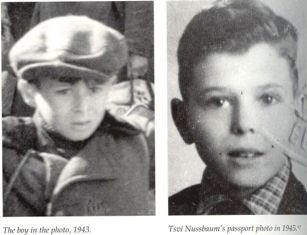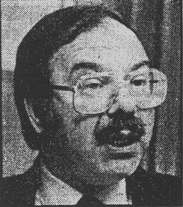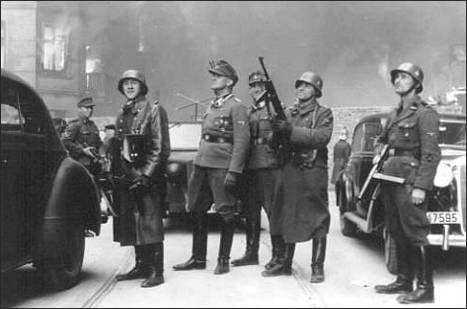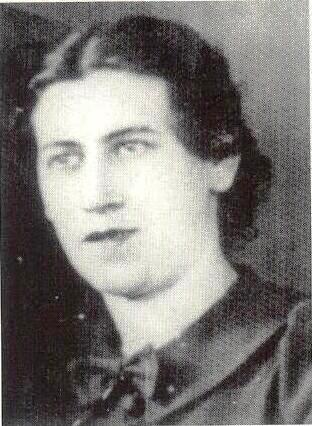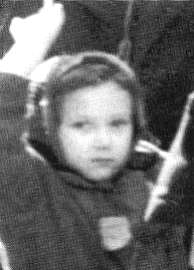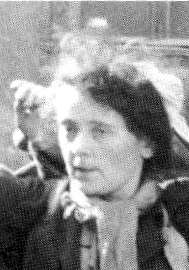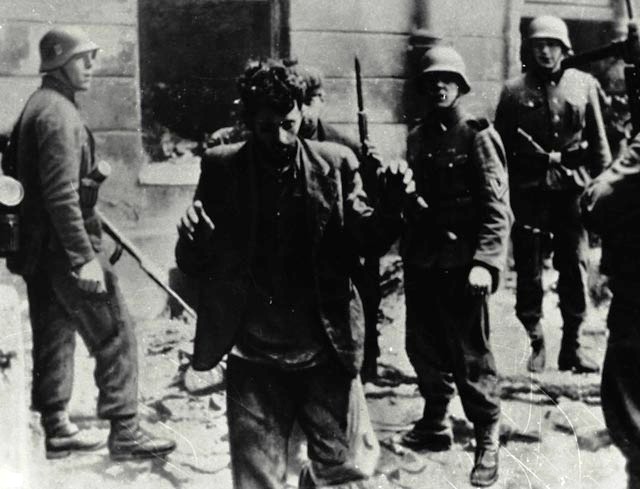Holocaust Education & Archive Research Team |
|
Occupation German Occupation of Europe Timeline
-
[The Occupied Nations]
Poland Austria Belgium Bulgaria Denmark France Germany Greece Hungary Italy Luxembourg The Netherlands Norway Romania Slovakia Soviet Union Sudetenland | ||||||
The Boy in the Photo? The Warsaw Ghetto & The Stroop Report
The above photo is one of the most iconic photographs of the Holocaust, the German Guard pointing the machine gun is known, the little boy is not known, but some of the other people captured in this photo, have been identified.
The photo was included in the infamous Stroop Report – “The Warsaw Ghetto no longer exists.”
-------------------------------------------------------------------------------------------------------------------------------------------------------------
Extracts from the book by Richard Raskin
The Boy in the Photograph
There are four possible identities for the little boy at gunpoint.
It was advanced as early as 1950, but documentation was first found in 1977-78, one source was responsible for making the claim, a woman named Jadwiga Piesecka, who was a resident of Warsaw.
According to a statement she signed on 24 January 1977, the boy in the photograph was named Artur Siemiatek born in Lowicz in 1935.
He was the son of Leon Siemiatek, and Sara Dab and the grandson of the signatory’s brother Josef Dab.
A similar attestation was signed the following year in Paris by Jadwiga Piesecka’s husband, Henryk Piasecki, dated 28 December 1978.
In 1982 a 47 year old ear, nose and throat specialist in Rockland County New York, came forward that in 1943, at the age of seven, he had been arrested in Warsaw and ordered to raise his hands by an SS man standing in front of him and aiming a gun at him. And although he could not recall that a photograph was taken, Dr Nussbaum believes that he might be the child in the picture.
Tsvi Nussbaum expressed uncertainty that he was the boy in the photo, whilst others say that it is him. There are indeed two specific factors that heavily way up, against him being that boy.
The first is that although he was arrested in Warsaw, he had never set foot in the ghetto- the second is the date he was arrested. Tsvi Nussbaum clearly remembers that he was arrested on 13 July 1943. This was nearly two months after the Stroop report is thought to have been completed, and sent to Himmler and Kruger.
In the early 30’s Nussbaum’s parents emigrated from Poland to Palestine, where Tsvi was born in 1935. When conflicts broke out between the Jews and the Arabs in Palestine, the Nussbaum family returned to Poland, settling in Sandomierz in 1939.
By 1942 Tsvi Nussbaum parents had been murdered by the Nazis, and he was brought from Sandomiercz to live with an Aunt and Uncle, in hiding, on the Aryan section of the city.
They looked after him for six months, but were caught in a Gestapo trap, the Nussbaums joined hundreds of other desperate Jews in the Hotel Polski and were put on the Palestine list. On 13 July 1943 trucks came to take them away, but not to Palestine, but Bergen Belsen.
At the concentration camp they were housed together in a special barracks, given better food and not forced to work. If the boy in the photo is Tsvi Nussbaum, then the picture would have to have been taken at the Hotel Polski, and not within the Warsaw Ghetto, where all of the photos from the Stroop Report, are generally thought to have been taken.
Dr Lucjan Dobroszycki is quoted in the New York Times article, doubts whether Tsvi Nussbaum is the boy in the photo, for the reasons set out below:
The scene he noted is on a street not in the courtyard in which the Hotel Polski roundup took place. Some of the Jews are wearing armbands that they surely would have shed while in the Aryan quarter of Warsaw.
The German soldiers would not have needed combat uniforms at the hotel. The heavy clothing worn by most of the Jews suggests that the photograph was taken in May – the date General Stroop put on the report – rather than July.
Moreover every other photograph in the Stroop Report was taken in the Warsaw ghetto.
Tsvi Nussbaum states:
“I am not claiming anything – there’s no reward, he said. I didn’t ask for this honour. I think it’s me, but I can’t honestly swear to it. A million and a half Jewish children were told to raise their hands.”
Lastly, with the help of someone trained in photo- comparison, Dr K.R. Burns a forensic anthropologist at the University of Georgia, compared the famous photo, with a passport photo of Tsvi Nussbaum taken in 1945 said the following:
Having examined the two photographs, Dr Burns said, that although the mouth, nose and cheek are consistent, there is one important disparity- the ear lobes on the 1943 boy appear to be attached, whereas the earlobes of the 1945 boy are not attached.
This generic trait cannot change with age and the difference indicates the pictures are not the same boy. The former Hotel Polski at 29 Dluga Street, entrance has been compared to the 1943 photo, but it is difficult to see whether it is the same building.
Avrahim Zelinwarger, aged 95, contacted the Ghetto Fighters House in Israel, in late 1999. He informed the museum that the boy in the photograph was his son Levi, as a result of that contact, the following information now accompanies the well known photograph, in their archives.
According to the testimony of Abraham Zelinwarger of Haifa, the boy is his son Levi, 1932 - he suggests that the photograph was taken in the ghetto on Kupiecka Street, near Nalewki Street.
The father, a women’s - hairdresser by profession worked at forced labour clearing rubble and damage at a burned out gas installation in Warsaw, and had escaped to Soviet territory at the beginning of 1940.
Avrahim Zelinwarger confirmed during a telephone conversation with Richard Raskin that the woman next to the boy, his mother was called Chana Zeilwarger.
Avrahim Zelinwarger believes that his wife, his 11 year old son Levi and his 9 year old daughter Irina all perished in a concentration camp in 1943.
A London Business man contacted the Jewish Chronicle in 1978 claiming that he was the little boy, not Artur Siemiatek, having seen a cropped version of the photograph. The man who contacted the paper asked that his name be withheld.
During his statement he claimed the photograph was taken in 1941 and he remembers he did not have any socks on, both these claims are without doubt incorrect, and therefore this anonymous survivor cannot be seriously considered.
According to the Yad Vashem Page of Testimony number 90540, completed in 1994 by her aunt, Esther Grosbard-Lamet, residing in Miami Beach Florida, the little girl was identified as Hanka Lamet.
The same document lists 1937 and Warsaw, as the year and place of the little girl’s birth while the place and circumstances of her death are listed as Majdanek- taken to Gas Chambers.
The USHMM website also indicates that the woman standing to the left of the little girl is her mother Matylda Lamet Goldfinger. The boy carrying the white sack near the rear of the group shown in the photograph was identified as Leo Kartuzinsky by his sister, Hana Ichengrin, according to an email from Yad Vashem, received by the author.
According to the USHMM the woman in the back right was identified as Golda Stavarowski, by her granddaughter Golda Shulkes, residing in Victoria Australia.
Who took the photographs?
The photographs included in the Stroop report were probably taken by a number of photographers, who worked for PK689, Propaganda Kompanie, who were active since the creation of the Warsaw Ghetto, recording scenes of Jewish life and death during the early years of the German occupation.
Albert Cusian, Erhard Josef Knoblach and Arthur Grimm were among the photographers of this unit. Whilst possibly Grimm took the photo, another candidate is Albert Cusian.
On a tip from a survivor of the Warsaw ghetto, Cusian was tracked down to a small German town near the Danish border by the Sunday Times of London and interviewed by Antony Terry.
On the basis of that interview Philip Knightley and Antony Terry then co-wrote an article published on 21 April 1968 titled 25 Years After -The Sunday Times tracks down the man who found “the subject matter so interesting,” and took these pictures of man’s inhumanity to man.”
The words “these pictures” ostensibly refer to the two photographs visible just to the right of the title, one of which is the picture of the boy with his hands raised, though that photograph isn’t specifically mentioned in the article. Philip Knightley confirmed that to the best of his recollection that Cusian made it clear that he had taken the infamous photo.
However, very different conclusions were reached by a Polish researcher Magdalene Kunicka – Wyrzykowska, who stated categorically in 1983 that the photographs in the Stroop Report were taken by the Security Police and SS- Obersturmfuhrer Franz Konrad, who was Leiter fur Weterfassung (confiscation of property in the Warsaw ghetto).
According to Magdalene Kunicka- Wyrzkowska, the photographs taken by the SD and Franz Konrad were collected by Stroop’s Chief of Staff Max Jesuiter, and from this collection, Stroop chose the pictures he would use in his report.
The SS Trooper: Josef Blosche
The one person in the photograph whose identity has been established beyond any doubt is the SD soldier aiming his sub-machine gun in the direction of the little boy.
He was SS-Rottenfuhrer Josef Blosche, a most feared predator, who was often teamed up with SS-Untersturmfuhrer Karl –Georg Brandt, and SS-Oberscharfuhrer Heinrich Klaustermeyer, to terrorize the occupants of the ghetto on hunting expeditions, randomly killing whomever they chose.
Blosche was born in Friedland in the Sudetenland, in 1912 and after joining the SS, saw service in Platerow, as a guard patrolling the Bug River. In May 1941 he was transferred to an SS post at Siedlce.
Following service in an Einsatzgruppen unit in Baranowitchi, he was transferred to Warsaw Security Police, where he took place in the Warsaw Ghetto uprising, and the uprising by Poles in August 1944..
Upon arrest Blosche made the following statement:
I have looked at the given photocopy. Concerning the person in the SS uniform standing in the foreground of a group of SS members and holding a sub-machine gun in firing position and wearing a steel helmet with motorcycle goggles, this is me.
The picture shows I, as member of the Gestapo office in the Warsaw Ghetto, together with a group of SS members, am driving a large number of Jewish citizens out from a house. The group of Jewish citizens is comprised predominantly of children, women and old people, driven out of a house through a gateway, with their arms raised.
The Jewish citizens were then led to the so-called Umschlagplatz, from which they were transported to the extermination camp Treblinka.
Signed: Josef Blosche
Blosche gave another statement at a subsequent interrogation:
I now recall a shooting of Jewish citizens in the Warsaw Ghetto. This took place at a time when there was no transportation to the extermination camp Treblinka. Brandt gave each of us at the SD office in the ghetto, a small box of pistol ammunition.
Beside me there was Ruhrenschopf, Klaustermeyer, and other Gestapo members, whose names I do not know any longer today. Brandt led us into the middle of the ghetto. I can no longer remember the exact time - I know the shooting took place in a courtyard, which one entered from the street through a gateway.
Beyond that I still know that during the shooting, a truck carrying Jewish citizens drove by. At that moment, I was standing at the entrance to the courtyard. How many Gestapo members were there I can no longer say exactly, it could have been 15 to 25
Signed: Josef Blosche
Berlin, 25 April 1967.
For his dedication and zeal during the Warsaw Ghetto uprising, Blosche was awarded the Cross of War Merit 2nd Class with Swords. During his trial in Erfurt in April 1969 Blosche was found guilty of war crimes, including the participation in the shooting of more than 1000 Jews in the courtyard of a building complex on the morning of 19 April 1943.
Blosche was executed in Leipzig on 29 July 1969, he was 57 years old, and buried in an unmarked grave.
Sources:
A Child at Gunpoint by Richard Raskin, published by Aarhus University Press 2004. Letzte Spuren by Helge Grabitz and Wolfgang Scheffler, published by Hentrich Berlin 1993. The SS-Man Josef Blosche – WDR TV Documentary 2003 by H. Schwan. Thanks to PJ for the donation of the book. Holocaust Historical Society PRO
Copyright CW H.E.A.R.T 2007
|
